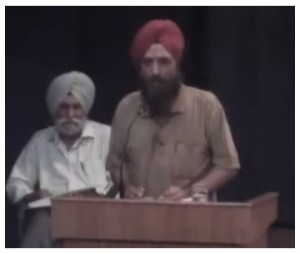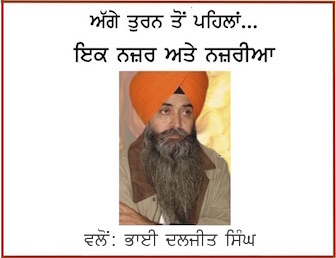Articles/Opinion
Fabricating a controversy – Indian Media and Sadda Haq
April 8, 2013 | By Sikh Siyasat Bureau
Two young Hindu boys were killed by some unknown persons on a day in early 1980s in Majha region of Punjab. A Journalist who was deployed at Amritsar by a news agency because of his Sikh appearance, while ideologically he had a leftist approach, was asked to send a specified news-story on this matter. The demand of the Chandigarh based news-desk was that the story must contain highly emotional lines showing the plight of newly wed brides of both the deceased young Hindus, whose life was ruined at the hand of Sikh extremists as they were turned into widows.
But when the journalist himself verified the facts, he came to know that both the deceased were unmarried. He immediately contacted the Chandigarh based news-desk and explained the true facts but the desk was not ready to listen to anything. The desk tried to lure him that the story shall be published on front page of a prominent English vernacular, so he should just follow their lines.
When the journalist refused to fabricate such a story the Chandigarh based news-desk published the same story on it’s own.

S. Jaspal Singh Sidhu (UNI Retd.) addressing a Seminar at Law Bhawan Chandigarh on April May 31, 2008
The name of that journalist is S. Jaspal Singh Sidhu, Senior Journalist (Retd.) UNI and he himself narrated above incident during a seminar at Law Bhawan, Chandigarh on 31 May 2008 while explaining the approach of Indian media towards the Sikh struggle. He was of the view that embedded journalism and fabrication marks two salient features of journalism in India.
In this backdrop we would analyze the recent news-stories published by almost all major section of Indian media regarding Baghi – a promotional song by Jazzy B for Sadda Haq Punjabi movie. Various sections of Indian media maintained that in Baghi song Sikh “militants/terrorists” (as the media has termed them) like Sant Jarnail Singh Bhindranwale, Balwant Singh Rajoana and Jagtar Sing Hawara were “equated” with Tenth Sikh Guru, Guru Gobind Singh Ji. Indian media claimed that such a comparison was unacceptable and unreasonable, besides being highly objectionable. Some section of the media went on to justify the ban while maintaining that the movie had equated Sant Bhindranwale with Tenth Sikh Guru; while others are questioning the authority of FCAT (Film Certification Appellate Tribunal) that had cleared the movie after the initial ban that was imposed by CBFC (Central Board of Film Certification).
 The song Baghi, that is not part of the Sadda Haq Movie and was sung for the promotion of the movie, draws a hereditary line from Guru Gobind Singh Ji to Baba Banda Singh Bahadur, S. Hari Singh Nalwa, Shaheed Udham Singh, Shaheed Kartar Singh Sarabha, Shaheed Bhagat Singh, Sant Jarnail Singh Bhindranwale, Bhai Balwant Singh Rajoana and to Bhai Jagtar Singh Hawara – in terms of their rebellion against the injustice and atrocities of the rulers.
The song Baghi, that is not part of the Sadda Haq Movie and was sung for the promotion of the movie, draws a hereditary line from Guru Gobind Singh Ji to Baba Banda Singh Bahadur, S. Hari Singh Nalwa, Shaheed Udham Singh, Shaheed Kartar Singh Sarabha, Shaheed Bhagat Singh, Sant Jarnail Singh Bhindranwale, Bhai Balwant Singh Rajoana and to Bhai Jagtar Singh Hawara – in terms of their rebellion against the injustice and atrocities of the rulers.
No one from the global Sikh community raised any objections on any part of the song, which is major evidence of it’s approval. No one said that there was anything inappropriate in this song.
But the Indian media started shouting foul and maintained that it was inappropriate to “equate” Guru Gohind Singh Ji with Sant Jarnail Singh Bhindranwale, Bhai Jagtar Singh Hawara and Bhai Balwant Singh Rajoana.
Here arises two questions: Firstly, and fundamentally, if any one else could be equated with the Sikh Gurus? Secondly, did the song equated the enumerated personalities with Guru Gobind Singh?
The answer to first question is simple and clear that – no. No one else could be equated with the Sikh Gurus, keeping in view the basic principles as well as historic tradition of the Sikh religion.
But, it is worth mentioning here that in the Sikh tradition the martyrs and the Khalsa occupies a very respectful place. Guru Gobind Singh Ji himself commanded that “Khalsa Mero Roop Hai Khas, Khalse Main Haun Karon Nivas” (Khalsa is my specific appearance, and I reside in the Khalsa) and “Rehni Rahe Soe Sikh Mera; Ouh Sahib, Main Uss Ka Chera” (One who obeys the code of life for a Sikh – is my Sikh; he is the master, and I am his follower). In Ardas (daily prayer) the Sikhs chant the names of Sikh martyrs after the names of Sikh Gurus. While doing so Sikhs do not equate the martyrs or the GurSikhs with the Guru Sahib but legitimately draws a hereditary line signifying that these GurSikhs followed the path shown by the Sikh Gurus.
It must be noted here that Sant Jarnail Singh Bhindranwale has been declared “National martyr” of the Sikhs by Akal Takhat, the permanent seat of Sikh sovereignty. Akal Takhat has endowed the title of “Living Martyr” on Bhai Rajoana and Bhai Jagtar Singh Hawara was addressed as “Qaumi Jarnail” (Nation’s warrior) during an ardas at Sri Akal Takhat Sahib.
Therefore, the answer to second question is equally clear that the song did not equate anybody else to the Tenth Sikh Guru, Sri Guru Gohind Singh Ji; rather it signified the fact that these personalities have followed the path shown by Sri Guru Gohind Singh Ji for just and pious causes – that is duly recognized by the entire Sikh nation and the Akal Takhat.
This must be clearly understood that for this reason the Sikhs did not find anything inappropriate in this song.
Now a question arises that why Indian media propagated such a false claim? But before answering this question it would be appropriate have some more insight to Indian media’s approach towards sensitive Sikh issues.
In 2007 the global Sikh community was outraged over the blasphemous activities committed by a Sirsa based self-styled godman Gurmeet Ram Rahim (head of Dera Sauda Sirsa – DSS). DSS head attempted to personify himself as the Tenth Sikh Guru Sri Guru Gobhind Singh, whereas personification of the Sikh Gurus is strictly prohibited in Sikh religion. He had attempted to copy the sacred and historic Sikh ceremony of Amrit that was initiated by Guru Gobind Singh Ji in 1699. Symbolizing the transformation of the Sikh into the Khalsa, Guru Gobind Singh Ji had command all Amritdhari Sikhs to wear Kakars (5 Ks) all the time and to affix “Singh” (for men) and “Kaur” (for Women) as their last name. During 2007’s blasphemous drama created by DSS head, he asked all his followers – taking Jam-e-Insan to wear symbol “1” at all the times and affix “Insan” as their last name as symbols of their transformation. There were enormous other things also that point towards the intentions of the dera head.
All this was propagated by Dera Sauda Sirsa as an open challenge to the Sikhs, that’s why the Sikhs were protesting against these blasphemous and provocative activities while demanding appropriate legal action against the Dera head.
At that time the Indian media reports said that it was a “controversy over the dress”. “Paushak Par Bawal” was repeated on Indian TV channels. By terming it merely a controversy over the dress the media was stereotyping the Sikhs before the world as an intolerant community that could get outraged over a matter of dress wearing. At the same time such coverage shed the exposure of real facts that had forced the Sikhs to come out on streets to protest against Dera Sauda Sirsa.
It would not be out of scope to say a few words about the movie Sadda Haq. The movie is based on the events of post-1984 to mid-1990s in Punjab. It’s a bold and brave attempt to address some basic questions related to the recent past of Punjab, such as – What were basis of struggle by people of Punjab? Why, and under what circumstances, the Sikh youth resorted to arms after 1984? What was the role of respective governments, at the Center or in Punjab? How the armed movement was tackled by the state and it’s security forces? How the people of Punjab suffered between two opposing barrels of guns? What is the current status of rightful issues of Punjab that were not addressed with sincerity by the Indian state? The movie talks about creating a mass awareness move through peaceful and democratic means.
The movie delivers a clear message that the events of 1980s-90s are the part of history now, but one can not turn blind eye towards these events. According to the makers of Sadda Haq, this film was made with a view that the younger generation must know their recent past, so that the mistakes of past are not repeated again.
During a recent Radio interview Dinesh Sood, actor-cum-co-producer of Sadda Haq movie said that being a Hindu he had many reservations about the plot of Sadda Haq Punjabi Movie.
He said that: ‘This movie was a dream project of Kuljinder Sidhu; but being a Hindu there were many questions to my mind that – why such a movie should be produced’.
‘My close friends forbade me (from making this movie) saying that – we all had seen that during that period many incidents were there’ he added.
He told that he held long discussions with Kuljinder Sidhu in this regard for over two years.
‘All my questions were adequately answered by Kuljinder; that – what was the truth of those incidents; and – what were the demands behind the movement and how the movement was defamed and what was the role of the government’ Dinesh Sood added.
He further said: ‘I used to listen his (Kuljinder’s) arguments carefully and discussed it with my people but they did not believe’.
‘Then I involved myself in research; started reading books and I realized that he (Kuljinder) was right; and there were misconceptions in minds of our people and the media did not present the reality, rather it was instrumental in creating misconceptions in the minds of the people’.
‘Then I realized that this movie must be made so that the people could know the reality’. He opined that the misconceptions in the mind of a community may get cleared after watching this movie.
Two important aspects flow out of instances as discussed above – firstly, the Indian Media did not present the real state of affairs surrounding Sikh struggle and Sikh issues; secondly – Indian media was indulged in fabricating the facts in order to embed misconceptions in the minds of people in order to defame Sikh movements.
The answers to the question that why Indian media attempted to fabricate an unwarranted controversy over the Baghi song by Jazzy B, are clear that: It has been a long standing practice of Indian media to fabricate facts and create such controversies to hamper the legitimate Sikh cause. Secondly, as in the words of Dinesh Sood, the movie might have cleared many misconceptions regarding the movement of 1980s-90s that were repeatedly propagated the Indian media, the media had a particular bias against the movie.
To Get Sikh Siyasat News Alerts via WhatsApp:
(1) Save Our WhatsApp Number 0091-855-606-7689 to your phone contacts; and
(2) Send us Your Name via WhatsApp. Click Here to Send WhatsApp Message Now.
Sikh Siyasat is on Telegram Now. Subscribe to our Telegram Channel
Related Topics: Dinesh Sood, Indian Media, Punjabi Movies, Sadda Haq





